Last Thursday, 21 February 2019, Peter Halsten Thorkelson (1942-2019), better known as Peter Tork, passed away. Tork was an American musician, composer and actor, best known as the keyboardist and bass guitarist of The Monkees. Assembled in Los Angeles in 1966 by Robert 'Bob' Rafelson and Bert Schneider for the television series The Monkees (1966-1968), the group members were Americans Micky Dolenz, Michael Nesmith and Peter Tork, and Englishman Davy Jones. They became known for such hits as I'm a believer.
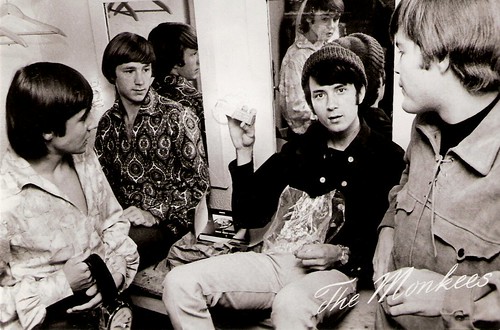
Dutch postcard by Uitg. en druk. 't Sticht, Utrecht, no. AX 6804.
Aspiring filmmaker Bob Rafelson developed the initial idea for The Monkees in 1962, but was unsuccessful in selling the series. He had tried to sell the idea for a television series about a fictional rock and roll group to Revue, the television division of Universal Pictures.
In May 1964, while working at Screen Gems, Rafelson teamed up with Bert Schneider, whose father, Abraham Schneider, headed the Colpix Records and Screen Gems Television units of Columbia Pictures. Rafelson and Schneider ultimately formed Raybert Productions and tried to get a foot in the door in Hollywood.
The Beatles' film A Hard Day's Night (Richard Lester, 1964) inspired Rafelson and Schneider to revive Rafelson's idea for The Monkees. As 'The Raybert Producers', they sold the show to Screen Gems Television in 1965.
Paul Mazursky and Larry Tucker completed a pilot script by August entitled 'The Monkeys'. Rafelson and Schneider wanted the style of the series to reflect avant garde film techniques — such as improvisation, quick cuts, jump cuts, breaking the fourth wall, and free-flowing, loose narratives — then being pioneered by European film directors.
Each episode would contain at least one musical 'romp' which might have nothing to do with the storyline. In retrospect, these vignettes now look very much like music videos: short, self-contained films of songs in ways that echoed the Beatles' recent ventures into promotional films for their singles. They also believed strongly in the program's ability to appeal to young people, intentionally framing the kids as heroes and the adults as heavies.
Rafelson and Schneider's original idea was to cast an existing New York folk rock group, The Lovin' Spoonful, who were not widely known at the time. However, John Sebastian, founder of The Lovin' Spoonful, had already signed the band to a record contract, which would have denied Screen Gems the right to market music from the show.
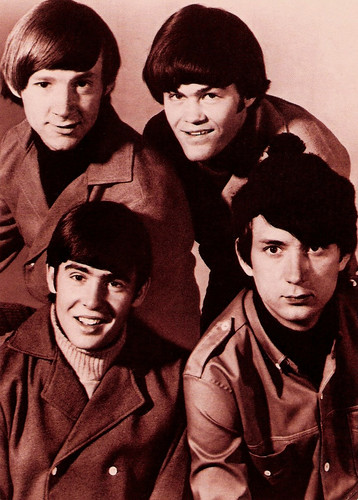
American postcard by Ludlow Sales, New York, N.Y., no. FC-250-50.
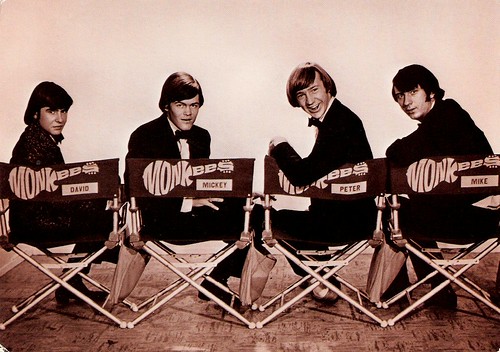
Vintage postcard.
On 14 July 1965, The Hollywood Reporter stated that future band member Davy Jones was expected to return to the United States in September 1965 after a trip to England "to prepare for [a] TV pilot for Bert Schneider and Bob Rafelson".
Englishman Davy Jones was a former jockey. He had previously starred as the Artful Dodger in the Broadway theatre show 'Oliver!', and his performance was later seen on The Ed Sullivan Show the same night as The Beatles' first appearance on that show, 9 February 1964. He was nominated for a Tony Award for Best Featured Actor in a Musical in 1963.
In September 1964, Jones was signed to a long-term contract to appear in TV programs for Screen Gems, make feature films for Columbia Pictures and to record music for the Colpix label. Rafelson and Schneider already had him in mind for their project after their plans for The Lovin' Spoonful fell through. When they chose him, Jones was essentially a proto-star looking for his lucky break.
Out of 437 applicants at an audition, the other three chosen for the cast of the TV show were Michael Nesmith, Peter Tork and Micky Dolenz. In The Monkees, Nesmith played guitar, Peter Tork played bass, Mickey Dolenz was their drummer, and Davey Jones was the lead-singer, a role he shared with Dolenz.
Michael Nesmith had been working as a musician since early 1963 and had been recording and releasing music under various names, including Michael Blessing and Mike & John & Bill and had studied drama in college. He showed up to the audition with his laundry and impressed Rafelson and Schneider with his laid-back style and droll sense of humour. He also wore a woollen hat to keep his hair out of his eyes when he rode his motorcycle, leading to early promotional materials which nicknamed him "Wool Hat". The hat remained part of Nesmith's wardrobe, but the name was dropped after the pilot. Of the final four, Nesmith was the only one who actually saw the ad in Daily Variety and The Hollywood Reporter.
Micky Dolenz was the son of veteran character actor George Dolenz. At the age of 10, Micky had starred in the TV series Circus Boy in the 1950s, using the stage name Mickey Braddock. Later he had also played guitar and sung in a band called the Missing Links, which had recorded and released a very minor single, 'Don't Do It'. By that time he was using his real name. Dolenz found out about The Monkees through his agent.
Peter Tork, the last to be chosen, had been working the Greenwich Village scene as a musician, and had shared the stage with Pete Seeger. He learned of The Monkees from Stephen Stills, whom Rafelson and Schneider had rejected as a songwriter. Rafelson and Schneider hired novice director James Frawley to teach the four actors improvisational comedy. Each of the four was given a different personality to portray: Dolenz the funny one, Nesmith the smart and serious one, Tork the naive one, and Jones the cute one. Their characters were loosely based on their real selves, with the exception of Tork, who was actually a quiet intellectual.
A pilot episode was shot in San Diego and Los Angeles on a shoestring budget—in many scenes the Monkees wore their own clothes. Initial audience tests (which were just then being pioneered) produced very low responses. Rafelson then re-edited the pilot and included some of the screen tests, to better introduce the band members to viewers. The re-cut pilot tested so well that NBC placed an order for two seasons of episodes.
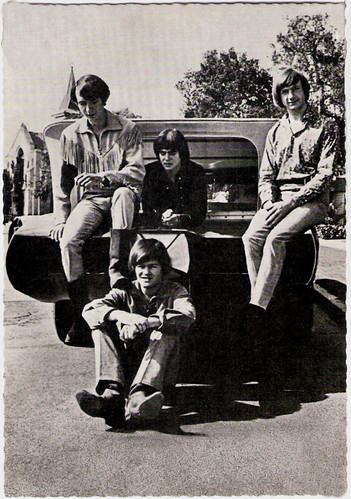
German postcard by Filmbilder-Vertrieb Ernst Freihoff, Essen, no. 108.

German postcard by Filmbilder-Vertrieb Ernst Freihoff, Essen, no. AX 6814.
The Monkees first aired on American TV in two long series between 12 September 1966 and 25 March 1968. The situation comedy follows the adventures of four young men trying to make a name for themselves as a rock 'n roll band, but they remain forever on the verge of stardom. They live together in a crazy apartment and are frequently drawn into the lives of California's many eccentrics. The adventures are interrupted by songs, written by such songwriters as Neil Diamond, Harry Nilsson, Carole King, and Boyce & Hart and others.
The Monkees became a huge pop culture sensation and won two Emmy awards. However, the public didn't realise that the show and the band were mostly a generally manufactured television series and that The Monkees themselves did not write or perform much of their own studio music, except to provide the vocals. The only exception were their live performances. When the truth became well known, there was a large backlash by many fans and music critics.
NBC responded to the backlash by retooling the show in its second season with The Monkees now writing and performing much of their own music that was much less pop-oriented. In addition, the first season's clean cut looks were replaced by more hippy looking attire. All this alienated the young fans who then deserted the group. The result was a huge decline in ratings and record sales. By 1967, NBC felt the series had run its course. Coupled with friction within the band itself, the series was cancelled in 1968.
Nonetheless, Nesmith did compose and produce some songs from the beginning, and Tork contributed limited guitar work on the sessions produced by Nesmith. All four contributed lead vocals to various tracks. They eventually fought for the right to collectively supervise all musical output under the band's name, acting as musicians, singers, songwriters and producers.
Dolenz described The Monkees as initially being "a TV show about an imaginary band... that wanted to be the Beatles that was never successful". Ironically, the success of the show led to the actor-musicians becoming one of the most successful bands of the 1960s. They had international hits with 'Last Train to Clarksville', 'Pleasant Valley Sunday', 'Daydream Believer', and 'I'm a Believer'.
In 1968, there was also a film, Head (Bob Rafelson, 1968), in which The Monkees are tossed about in a psychedelic, surrealist, plotless, circular bit of fun fluff. Actor Jack Nicholson wrote the script. Scott Mercer at IMDb: "I believe that Jack Nicholson and The Monkees (writers of the film, though only Jack was credited) took a carefully-applied scalpel to their situation in particular and society in general, dissecting and laying bare their frustrations in an artful manner. Ultimately Head is an allegorical tragedy that metaphorically, and with panache, tells the story of The Monkees' rise and their ultimate disillusionment with and revolt against, the star-making machinery that gave them fame and fortune."
The film was not a commercial success, but over the intervening years Head has developed a cult following for its innovative style and anarchic humour. The television show was cancelled in 1968, at the finish of its second season, but received a long afterlife with many repeats. The Monkees continued to record music and released three more albums after the series cancellation but they did not chart well. In 1971, the group broke up.
In the 1980s, The Monkees enjoyed a revival, after MTV aired a Monkees marathon in 1986. The group has reunited and toured several times since then with different line-ups and varying degrees of success. Jones died in February 2012 and Tork died in February 2019. Dolenz and Nesmith remain active members of the group.
The Monkees have sold more than 75 million records worldwide making them one of the biggest selling groups of all time. Newspapers and magazines reported that The Monkees outsold The Beatles and The Rolling Stones combined in 1967, but Nesmith claims in his autobiography 'Infinite Tuesday' that it was a lie that he told a reporter.
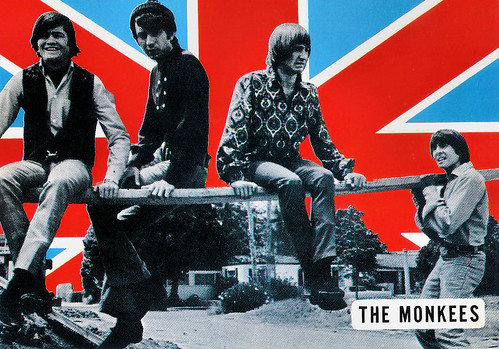
French postcard by PSG, no. 1404.
The Monkees perform I'm a Believer. Source: Classicrockfan611 (YouTube).
Source: Scott Mercer (IMDb), Wikipedia and IMDb.

Dutch postcard by Uitg. en druk. 't Sticht, Utrecht, no. AX 6804.
A pilot script entitled 'The Monkeys
Aspiring filmmaker Bob Rafelson developed the initial idea for The Monkees in 1962, but was unsuccessful in selling the series. He had tried to sell the idea for a television series about a fictional rock and roll group to Revue, the television division of Universal Pictures.
In May 1964, while working at Screen Gems, Rafelson teamed up with Bert Schneider, whose father, Abraham Schneider, headed the Colpix Records and Screen Gems Television units of Columbia Pictures. Rafelson and Schneider ultimately formed Raybert Productions and tried to get a foot in the door in Hollywood.
The Beatles' film A Hard Day's Night (Richard Lester, 1964) inspired Rafelson and Schneider to revive Rafelson's idea for The Monkees. As 'The Raybert Producers', they sold the show to Screen Gems Television in 1965.
Paul Mazursky and Larry Tucker completed a pilot script by August entitled 'The Monkeys'. Rafelson and Schneider wanted the style of the series to reflect avant garde film techniques — such as improvisation, quick cuts, jump cuts, breaking the fourth wall, and free-flowing, loose narratives — then being pioneered by European film directors.
Each episode would contain at least one musical 'romp' which might have nothing to do with the storyline. In retrospect, these vignettes now look very much like music videos: short, self-contained films of songs in ways that echoed the Beatles' recent ventures into promotional films for their singles. They also believed strongly in the program's ability to appeal to young people, intentionally framing the kids as heroes and the adults as heavies.
Rafelson and Schneider's original idea was to cast an existing New York folk rock group, The Lovin' Spoonful, who were not widely known at the time. However, John Sebastian, founder of The Lovin' Spoonful, had already signed the band to a record contract, which would have denied Screen Gems the right to market music from the show.

American postcard by Ludlow Sales, New York, N.Y., no. FC-250-50.

Vintage postcard.
A proto-star looking for his lucky break
On 14 July 1965, The Hollywood Reporter stated that future band member Davy Jones was expected to return to the United States in September 1965 after a trip to England "to prepare for [a] TV pilot for Bert Schneider and Bob Rafelson".
Englishman Davy Jones was a former jockey. He had previously starred as the Artful Dodger in the Broadway theatre show 'Oliver!', and his performance was later seen on The Ed Sullivan Show the same night as The Beatles' first appearance on that show, 9 February 1964. He was nominated for a Tony Award for Best Featured Actor in a Musical in 1963.
In September 1964, Jones was signed to a long-term contract to appear in TV programs for Screen Gems, make feature films for Columbia Pictures and to record music for the Colpix label. Rafelson and Schneider already had him in mind for their project after their plans for The Lovin' Spoonful fell through. When they chose him, Jones was essentially a proto-star looking for his lucky break.
Out of 437 applicants at an audition, the other three chosen for the cast of the TV show were Michael Nesmith, Peter Tork and Micky Dolenz. In The Monkees, Nesmith played guitar, Peter Tork played bass, Mickey Dolenz was their drummer, and Davey Jones was the lead-singer, a role he shared with Dolenz.
Michael Nesmith had been working as a musician since early 1963 and had been recording and releasing music under various names, including Michael Blessing and Mike & John & Bill and had studied drama in college. He showed up to the audition with his laundry and impressed Rafelson and Schneider with his laid-back style and droll sense of humour. He also wore a woollen hat to keep his hair out of his eyes when he rode his motorcycle, leading to early promotional materials which nicknamed him "Wool Hat". The hat remained part of Nesmith's wardrobe, but the name was dropped after the pilot. Of the final four, Nesmith was the only one who actually saw the ad in Daily Variety and The Hollywood Reporter.
Micky Dolenz was the son of veteran character actor George Dolenz. At the age of 10, Micky had starred in the TV series Circus Boy in the 1950s, using the stage name Mickey Braddock. Later he had also played guitar and sung in a band called the Missing Links, which had recorded and released a very minor single, 'Don't Do It'. By that time he was using his real name. Dolenz found out about The Monkees through his agent.
Peter Tork, the last to be chosen, had been working the Greenwich Village scene as a musician, and had shared the stage with Pete Seeger. He learned of The Monkees from Stephen Stills, whom Rafelson and Schneider had rejected as a songwriter. Rafelson and Schneider hired novice director James Frawley to teach the four actors improvisational comedy. Each of the four was given a different personality to portray: Dolenz the funny one, Nesmith the smart and serious one, Tork the naive one, and Jones the cute one. Their characters were loosely based on their real selves, with the exception of Tork, who was actually a quiet intellectual.
A pilot episode was shot in San Diego and Los Angeles on a shoestring budget—in many scenes the Monkees wore their own clothes. Initial audience tests (which were just then being pioneered) produced very low responses. Rafelson then re-edited the pilot and included some of the screen tests, to better introduce the band members to viewers. The re-cut pilot tested so well that NBC placed an order for two seasons of episodes.

German postcard by Filmbilder-Vertrieb Ernst Freihoff, Essen, no. 108.

German postcard by Filmbilder-Vertrieb Ernst Freihoff, Essen, no. AX 6814.
One of the biggest selling groups of all time
The Monkees first aired on American TV in two long series between 12 September 1966 and 25 March 1968. The situation comedy follows the adventures of four young men trying to make a name for themselves as a rock 'n roll band, but they remain forever on the verge of stardom. They live together in a crazy apartment and are frequently drawn into the lives of California's many eccentrics. The adventures are interrupted by songs, written by such songwriters as Neil Diamond, Harry Nilsson, Carole King, and Boyce & Hart and others.
The Monkees became a huge pop culture sensation and won two Emmy awards. However, the public didn't realise that the show and the band were mostly a generally manufactured television series and that The Monkees themselves did not write or perform much of their own studio music, except to provide the vocals. The only exception were their live performances. When the truth became well known, there was a large backlash by many fans and music critics.
NBC responded to the backlash by retooling the show in its second season with The Monkees now writing and performing much of their own music that was much less pop-oriented. In addition, the first season's clean cut looks were replaced by more hippy looking attire. All this alienated the young fans who then deserted the group. The result was a huge decline in ratings and record sales. By 1967, NBC felt the series had run its course. Coupled with friction within the band itself, the series was cancelled in 1968.
Nonetheless, Nesmith did compose and produce some songs from the beginning, and Tork contributed limited guitar work on the sessions produced by Nesmith. All four contributed lead vocals to various tracks. They eventually fought for the right to collectively supervise all musical output under the band's name, acting as musicians, singers, songwriters and producers.
Dolenz described The Monkees as initially being "a TV show about an imaginary band... that wanted to be the Beatles that was never successful". Ironically, the success of the show led to the actor-musicians becoming one of the most successful bands of the 1960s. They had international hits with 'Last Train to Clarksville', 'Pleasant Valley Sunday', 'Daydream Believer', and 'I'm a Believer'.
In 1968, there was also a film, Head (Bob Rafelson, 1968), in which The Monkees are tossed about in a psychedelic, surrealist, plotless, circular bit of fun fluff. Actor Jack Nicholson wrote the script. Scott Mercer at IMDb: "I believe that Jack Nicholson and The Monkees (writers of the film, though only Jack was credited) took a carefully-applied scalpel to their situation in particular and society in general, dissecting and laying bare their frustrations in an artful manner. Ultimately Head is an allegorical tragedy that metaphorically, and with panache, tells the story of The Monkees' rise and their ultimate disillusionment with and revolt against, the star-making machinery that gave them fame and fortune."
The film was not a commercial success, but over the intervening years Head has developed a cult following for its innovative style and anarchic humour. The television show was cancelled in 1968, at the finish of its second season, but received a long afterlife with many repeats. The Monkees continued to record music and released three more albums after the series cancellation but they did not chart well. In 1971, the group broke up.
In the 1980s, The Monkees enjoyed a revival, after MTV aired a Monkees marathon in 1986. The group has reunited and toured several times since then with different line-ups and varying degrees of success. Jones died in February 2012 and Tork died in February 2019. Dolenz and Nesmith remain active members of the group.
The Monkees have sold more than 75 million records worldwide making them one of the biggest selling groups of all time. Newspapers and magazines reported that The Monkees outsold The Beatles and The Rolling Stones combined in 1967, but Nesmith claims in his autobiography 'Infinite Tuesday' that it was a lie that he told a reporter.

French postcard by PSG, no. 1404.
The Monkees perform I'm a Believer. Source: Classicrockfan611 (YouTube).
Source: Scott Mercer (IMDb), Wikipedia and IMDb.
No comments:
Post a Comment